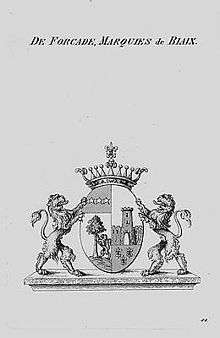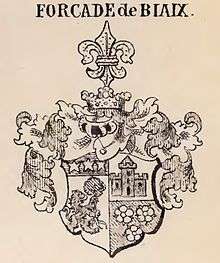Friedrich Heinrich Ferdinand Leopold von Forcade de Biaix
Friedrich Heinrich Ferdinand Leopold von Forcade de Biaix,[1] aka Heinrich Friedrich Ferdinand Leopold von Forcade de Biaix,[2] aka Friedrich Heinrich Ferdinand Leopold Marquis de Forcade de Biaix[3] (* 19 December 1747,[1] Berlin; † 12 October 1808,[1] Schleibitz Manor,[4] Oels, Silesia), was a Royal Prussian Lieutenant Colonel. He participated in the Rhine Campaigns,[1] during which he was awarded the Kingdom of Prussia's highest military order of merit for heroism, Knight of the Order of Pour le Mérite[1][3] and was Castellan (Drost) of Neuenrade in the County of Mark.[1] He was the owner of Schleibitz Manor,[5] near Oels, Silesia, at the time of his death.[4]
He was the third son,[1] of Royal Prussian Lieutenant General Friedrich Wilhelm Quirin von Forcade de Biaix, one of King Frederick the Great's most active and most treasured officers. His baptismal Godfather was none less than His Majesty Frederick the Great. As a gift, the King ordered his father to accept the hereditary title of Drost zu Neuenrade ("Castellan of Neuenrade") in the County of Mark with the royal command that it be transferred to him upon his death.[6]
Military career
He followed the military tradition of his family, and:
- entered Prussian military service in 1761 in his father's Regiment, the 23rd Prussian Infantry Regiment.[1]
- participated at the Siege of Schweidnitz (4 August 1762 - 10 October 1762) during the Third Silesian War
- fought in the Battle of Freiberg (29 October 1762) during the Third Silesian War
- 1774, transferred to the 28th Prussian Infantry Regiment in Brieg, Silesia.[1]
- 19 March 1788, as a Major, appointed as Battalionschef of the 15th Füsilier Battalion in Löwenberg, Silesia.[1][7]
- September 1791, awarded the Kingdom of Prussia's highest military order of merit for heroism, Knight of the Order of Pour le Mérite.[1][3]
- 13 November 1791, appointed as Battalion Commander of the 10th Füsilier Battalion in Neumarkt, Silesia, with which he fought during the Rhine Campaigns.[1]
- 1793, retired from active military service for reason of invalidity.[1]
- 1798, promoted to the rank of Lieutenant Colonel from His Majesty, Frederick William III of Prussia.[1]
Family
Coat of Arms

The family motto of the Prussian branch is "In Virtute Pertinax".[8]
Coat of Arms: An escutcheon with the field divided into four parts. Left half: argent tincture, a gules lion holding a sinople eradicated oak tree between its paws; azure tincture charged with three or mullets; Right half: a gules castle with three towers on an argent tincture; sinople tincture charged with three argent roses below it. A Grafenkrone (Count's coronet) as helmut on top of the escutcheon, crested with a or fleur-de-lis. Two or lions supporting the escutcheon. Motto: "In Virtute Pertinax".
Heraldic Symbolism: The lion symbolizes courage; the eradicated oak tree symbolizes strength and endurance; the towers are symbols of defense and of individual fortitude; the mullets (5-star) symbolizes divine quality bestowed by god; the rose is a symbol of hope and joy; the fleur-de-lis is the floral emblem of France; the coronet is a symbol of victory, sovereignty and empire. A Count's coronet to demonstrate rank and because the family originally served the counts of Foix and Béarn during the English Wars in the Middle Ages.
Parents
His father was Friedrich Wilhelm Quirin von Forcade de Biaix (1698-1729), one of King Frederick the Great's most active and most treasured officers.[6][10] Twice wounded and left for dead on the battlefield, he was Regimentschef of the 23rd Prussian Infantry Regiment,[11][12] recipient of the Kingdom of Prussia's highest military order of merit for heroism, Knight of the Order of Pour le Mérite,[13] Knight of the Order of the Black Eagle,[6][11][13][14] Canon of Havelberg,[6] Castellan of Neuenrade in the County of Mark,[13] Lord Seneschal of Zinna,[6][10][11][13] President of the Ober-Collegium Sanitatis in Berlin and Lieutenant governor of Breslau.[11] He married in 1727 at the French Cathedral in Berlin with Marie de Montolieu, Baronne de St.-Hippolyte[10][15] aka Maria von Montaulieu, Freiin von St.-Hippolyte (1709-1767), daughter of Sardinian and Prussian Major General[15] Louis de Montolieu, Baron de St.-Hippolyte († 1738, Berlin), also a Huguenot exile.
Marriage
Friedrich Heinrich Ferdinand Leopold von Forcade de Biaix married in 1782[1] at Ossen Manor in Oels, Silesia, to Wilhelmine von Koshembahr und Skorkau[1] (1762-????), from the house of Ossen.[6] She was the daughter of Christian Leopold von Koschembahr und Skorkau, Herr of Ober- and Nieder-Ossen, Pühlau, Dörndorf and Jacobsdorf, and his 2nd wife Charlotte Wilhelmine Wutge von Wutgenau.
Children
The couple had three sons[1] from their marriage:
- Friedrich Wilhelm Leopold Konstantin Quirin von Forcade de Biaix,[1] Herr of Schleibitz, Hamm, Groß-Naedlitz and Loslau, (* 12 May 1784, Berlin; † 22 October 1840, Breslau[4]), Royal Prussian Major, Knight of the Iron Cross 2nd Class,[4] recipient of the Kingdom of Prussia's highest military order of merit for heroism, Knight of the Order of Pour le Mérite, Knight of the Cross of the Royal Prussian Order of St. John Bailiwick of Brandenburg,[1][4] Royal Prussian Chamberlain,[1] and Castellan of Neuenrade in the County of Mark.[1]
- Wilhelm Friedrich Erdmann Ferdinand von Forcade de Biaix (26 February 1786, Brieg, Silesia; † 1816), Imperial Russian Army Lieutenant, Adjutant to Imperial Russian Army Infantry General Loggin Ossipovitch Rot ("von Roth"), recipient of the Kingdom of Prussia's highest military order of merit, Knight of the Order of Pour le Mérite (1814).
- Friedrich Wilhelm Ferdinand Ernst Heinrich von Forcade de Biaix[1] (* 7 October 1787,[1] Brieg, Silesia; † 14 Nov 1835,[16] presumably in Rawitsch, Silesia[4]), Royal Prussian Major,[16] Commanding Officer of the 10th Prussian Division's Garrison Company[16] and Knight of the Iron Cross 2nd Class.[4][16]
Other Family
- Brother: Friedrich Wilhelm von Forcade de Biaix[1] (ca. 1729-1778), the eldest son,[1] Royal Prussian Colonel, Schwadronschef (Rittmeister) of the 2nd Grenadier Company in the 24th Prussian Infantry Regiment, and, after 1 July 1761, acting Regimentschef[1] of the 24th Prussian Infantry Regiment[1] garrisoned in Frankfurt/Oder,[1] recipient of the Kingdom of Prussia's highest military order of merit for heroism, Knight of the Order of Pour le Mérite[1]
- Brother: Georg Friedrich Wilhelm von Forcade de Biaix[1] (1746-1811), the second-born son,[1] Royal Prussian Major[1] in the 1st Hussar Regiment[1]
Titles and Offices
Historical terms, in particular those related to offices, titles and awards, are often outdated in their usage to the point that modern dictionaries no longer contain them. To understand their meaning in the present day context it is necessary to look into dictionaries from the period. Historical terms in German used in the production of this article, and their English definitions, include:
Drost zu Neuenrade
Castellan of Neuenrade
- Drost (der): synonym with "Landdrost", "Landshauptmann" and "Landsvogt"; a Lord Seneschal, a Governor of a certain part of a country, an Upper Bailiff, a Castellan See: Ebers, Johann, The New And Complete Dictionary Of The German And English Languages: composed chiefly after the German Dictionaries of Mr. Adelung and of Mr. Schwan / 1: ... Containing the Letters A - G of the German Alphabet explained in English, Leipzig 1796, Page 618 (in German and English)
Notes
- 1 2 3 4 5 6 7 8 9 10 11 12 13 14 15 16 17 18 19 20 21 22 23 24 25 26 27 28 29 30 31 32 33 Zedlitz-Neukirch, Band 4, Page 391 (in German)
- ↑ Blažek, Part 3, Page 131 (in German)
- 1 2 3 Lehmann, Band 1, Page 209, Nr. 145 (in German)
- 1 2 3 4 5 6 7 Zedlitz-Neukirch, Band 2, Page 180 (in German)
- 1 2 Blažek, Part 3, Page 132 (in German)
- 1 2 3 4 5 6 Zedlitz-Neukirch, Band 4, Page 390 (in German)
- ↑ Gieraths, Band 8, Page 189 (in German)
- ↑ Champeaux, Page 105 (in French)
- ↑ Blažek, Part 3, Page 267, Table 85 (in German)
- 1 2 3 Zedlitz-Neukirch, Band 2, Page 179 (in German)
- 1 2 3 4 Heinsius, Issue 52, Page 241, Nr. V (in German)
- ↑ Gieraths, Band 8, Page 79 (in German)
- 1 2 3 4 König, Band 1, Page 430 (in German)
- ↑ Ledebur, Band 17, Page 43 (in German)
- 1 2 König, Band 1, Page 431 (in German)
- 1 2 3 4 Zedlitz-Neukirch, Band 4, Page 392 (in German)
References
- Blažek, Konrad: J. Siebmacher's grosses und allgemeines Wappenbuch in einer neuen, vollständig geordneten und reich vermehrten Auflage mit heraldischen und historisch- genealogischen Erläuterungen; Sechsten Bandes Achte Abtheilung. Der abgestorbene Adel der Preussischen Provinz Schlesien. Dritter Theil, Nürnberg 1894, Page 131 & Page 267 Table 85. (in German)
- Champeaux, Joseph de: Devises, cris de guerre, légendes, dictons, Dijon 1890, Page 105. (in French)
- Gieraths, Günther: Die Kampfhandlungen der brandenburgisch-preussischen Armee, 1626-1807, Band 8, Berlin 1964, Page 189. (in German)
- Heinsius, Johann Samuel (Verlag): Fortgesetzte neue genealogisch-historische Nachrichten von den vornehmsten Begebenheiten, welche sich an den europäischen Höfen zutragen, worinn zugleich vieler Stands-Personen Lebens-Beschreibungen vorkommen. Der 49.-54. Theil (1764-1765), Leipzig 1766, Page 241, Nr. V (in German)
- Kneschke, Ernst Heinrich: Neues allgemeines Deutsches Adels-Lexicon, Band 3, Leipzig 1861, Pages 293-294. (in German)
- König, Anton Balthasar: Biographisches Lexikon aller Helden und Militairpersonen, welche sich in Preußischen Diensten berühmt gemacht haben: A - F, Band 1, Pages 429-432. (in German)
- Lehmann, Gustaf: Die Ritter des Ordens pour le mérite. Auf Allerhöchsten Befehl Seiner Majestät des Kaisers und Königs, bearbeitet im Königlichen Kriegsministerium durch Gustav Lehmann, wirklichen geheimen Kriegsrat und vortragenden Rat im Kriegs-Ministerium, Erster Band: 1740-1811, Berlin 1913, Page 209, Nr. 145 (in German)
- Zedlitz-Neukirch, Leopold von: Neues preußisches Adelslexicon oder genealogische und diplomatische Nachrichten von den in der preussischen Monarchie ansässigen oder zu derselben in Beziehung stehenden fürstlichen, gräflichen, freiherrlichen und adeligen Häusern mit der Angabe ihrer Abstammung, ihres Besitzthums, ihres Wappens und der aus ihnen hervorgegangenen Civil- und Militärpersonen, Helden, Gelehrten und Künstler: E - H, Band 2, 1836, Pages 179-180. (in German)
- Zedlitz-Neukirch, Leopold von: Neues preußisches Adelslexicon oder genealogische und diplomatische Nachrichten von den in der preussischen Monarchie ansässigen oder zu derselben in Beziehung stehenden fürstlichen, gräflichen, freiherrlichen und adeligen Häusern mit der Angabe ihrer Abstammung, ihres Besitzthums, ihres Wappens und der aus ihnen hervorgegangenen Civil- und Militärpersonen, Helden, Gelehrten und Künstler: P - Z, Band 4, 1837, Pages 390-392. (in German)
Literature
- Lehmann, Gustaf: Die Ritter des Ordens pour le mérite. Auf Allerhöchsten Befehl Seiner Majestät des Kaisers und Königs, bearbeitet im Königlichen Kriegsministerium durch Gustav Lehmann, wirklichen geheimen Kriegsrat und vortragenden Rat im Kriegs-Ministerium, Erster Band: 1740-1811, Berlin 1913 (in German)
- Lehmann, Gustaf: Die Ritter des Ordens pour le mérite. Auf Allerhöchsten Befehl Seiner Majestät des Kaisers und Königs, bearbeitet im Königlichen Kriegsministerium durch Gustav Lehmann, wirklichen geheimen Kriegsrat und vortragenden Rat im Kriegs-Ministerium, Zweiter Band: 1812-1913, Berlin 1913, (in German)
